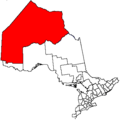References
- ↑ "Population and dwelling counts: Canada and designated places". Statistics Canada. February 9, 2022. Retrieved Sep 2, 2022.
49°43′01″N92°36′00″W / 49.717°N 92.600°W / 49.717; -92.600
| | This Kenora District geographical article is a stub. You can help Wikipedia by expanding it. |
